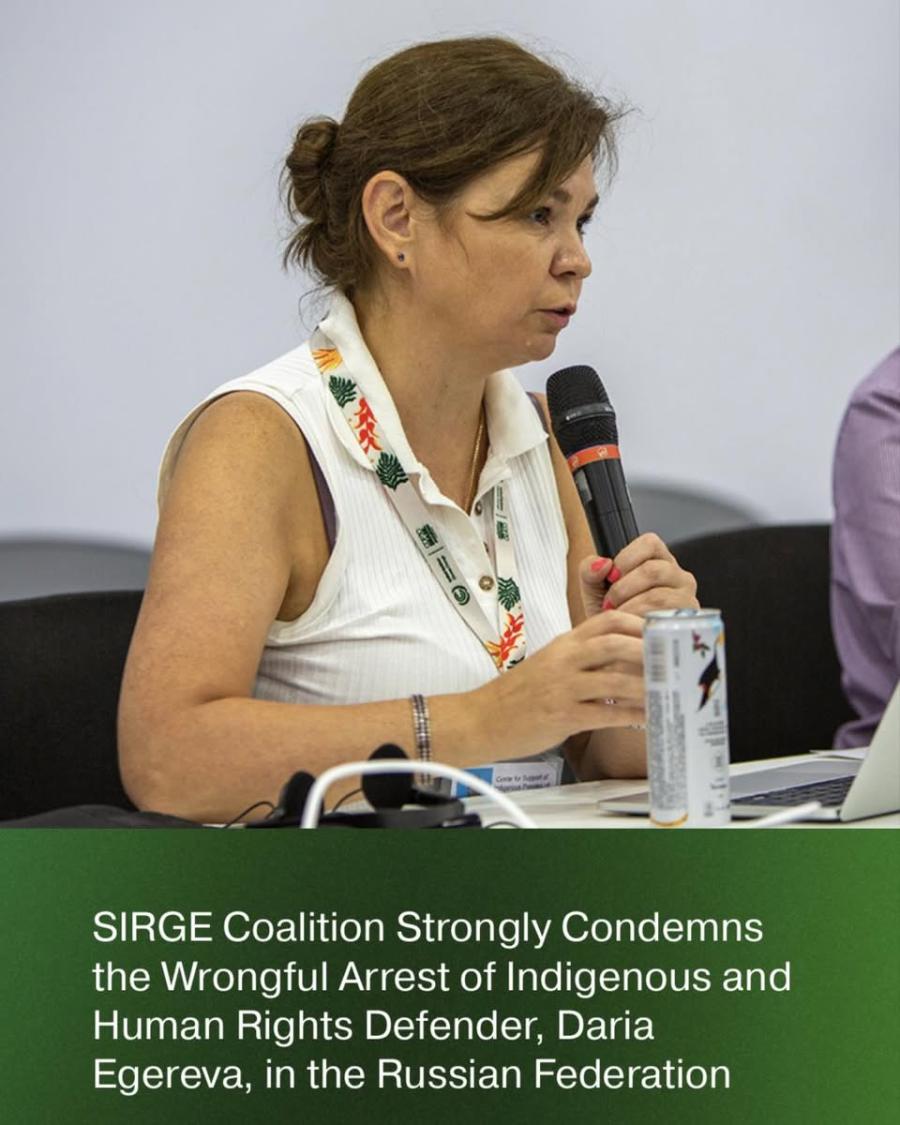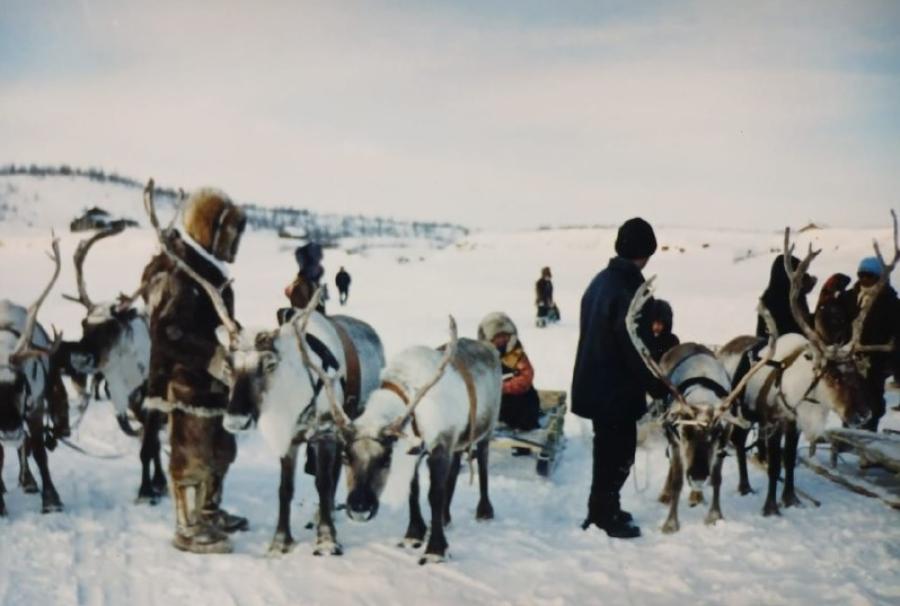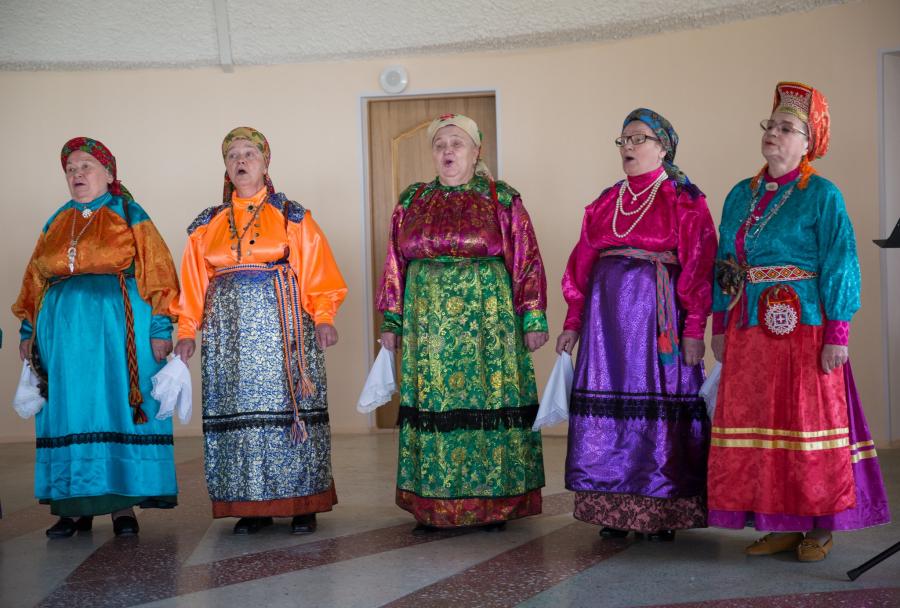While the West applauds the collapse of the Soviet Union, the disintegration of the Center as an effective political force in Russia has fostered the rapid development of a freebooting, frontier capitalism in western Siberia, based on oil and gas. While some attention has been paid lately to environmental issues in Russia, especially after the Usinsk oil spill in Komi, the issue has not been focused sharply enough. This war against the environment is also a war against traditional peoples, and West Siberia is the front line. "We are fighting for the last kilometers of our land," Vera Sopochina, a Khanty woman living just north of Surgut, told us.
The Khanty are one of the largest of the 23 "small nations," as the Soviets called the tribal peoples of Siberia, whose numbers total only a little over a million. Among the 22,000 or so Khanty, three groups - Northern, Southern, Eastern - can be distinguished by differences in dialect, subsistence patterns, and material culture. Called the Ostyak in russian ethnographic literature, the Khanty live in the taiga among the low hills and marshlands along the banks and tributaries of the Ob' and Irtysh Rivers, the third largest river system in the world. Traditionally they did not live in villages but in widely scattered, extended family settlements, where they continue to avail themselves of traditional family hunting territories. Everywhere they support themselves through hunting, and trapping of sable and fox. Fish constitute 70% of their diet, but reindeer herding is common north of the Ob'. Many are literate in Russian and fluently bilingual, but prefer to speak Khanty. And despite the efforts of the Orthodox Church, which in some areas has gained converts of varying degrees of allegiance, and despite the suppression of native religion under the Soviets, traditional belief and ritual still flourish.
Big Oil, Black Snow
Today West Siberia is the site of one of the world's most extensive petroleum deposits. The process of development, begun in the late 1960s with the first discoveries of oil, has always been characterized by a minimal regard for environmental protection, preservation of cultural properties, and effective consultation with indigenous peoples. The 1970s were marked by the forcible relocation of Khanty families from their traditional family hunting territories or the destruction of the natural resources of occupied family territories which eventually forced the families to voluntarily relocate. The result is that - after 5,000 years of occupancy - there are today virtually no traditional Khanty family settlements on Vakh, Agan, Salim, and Vas-Yugan Rivers, though these were all well-populated areas, rich in terms of traditional economy, twenty years ago. Other river systems like Pim and Trom-Agan are heavily impacted and the Khanty are marginalized. Only the Khanty families of Lamin and Yugan River systems have been minimally impacted. By 1989 oil was booming; Surgut had over 300,000 people, all tied to oil.
However it may be regarded elsewhere, the collapse of the Soviet Union, it is fair to say, has been disastrous for Western Siberia. Privatization led to the dissolution of the state oil monopoly, and production was turned over to regional oil companies, often directed by men who are wealthy and powerful enough to control the regional, okrug and oblast dumas and administrations. Profit-taking coupled with the internal debt crisis has meant that deteriorating pipelines and aging equipment are not replaced; loss of profits from reduced productivity of individual well clusters (some leave more than 50% of the oil in the ground) and spillage (over 3,000 pipeline breaks a year) drive the expansion of new territories for production. Russian regional oil companies routinely violate environmental regulations which impose only token financial penalties. Laws passed by both the central and okrug governments requiring the oil companies to obtain signed lease/compensation agreements from Khanty families before any work can be done are fraudulently implemented, and signatures on leases are still being obtained by coercion, false promises, administrative intimidation, even forgery. Major Western oil companies such as ELF-Aquitaine, Shell, AMOCO, CONOCO, and others are partnering with these rich, regional oil companies, often with investment that is partially underwritten by multinational lenders like the World Bank or by the sale of shares in the big Russian holding companies like LUKOil and YUKOS, some of which are now traded in the West.
Against this power, the Khanty themselves have no effective voice. There is not one Khanty representative in the okrug or regional dumas; by contrast, four of the nine members of the Surgut regional duma represent oil companies. In 1993 Yeltsin dissolved the system of village councils, in which Khanty at least had a local voice, and replaced them with village administrators, appointed by the regional government and confirmed in Moscow. These administrators are always Russians whose responsiveness to the pressure of regional administration, the oil companies, and the migrant oil workers who live in the village far outweighs any sense of obligation to the traditional Khanty families. To compound the difficulties of the Khanty, the state structures that formerly provided them with some economic support are virtually ineffective. Traditional Khanty families can sell neither furs nor fish nor meat to state production agencies in quantities or at prices sufficient to support their families, who are also now forced to deal with inflation and commercial grocery stores.
The Impact of Oil on the Khanty
Without protection, Khanty people feel the pressure of oil and gas exploration on the traditional Khanty hunting lands and on their culture. Soil pollution from pipeline breaks and settling pits has ruined large areas. Surface waters in this wetlands environment typically contain seven to 20 times the maximum permissible amount of petroleum hydrocarbons. Depositions of sulfur and nitrogen from chemical discharges prove to be two to three times the maximum permissible level, and the high incidence of acid rain and snow is destroying the taiga, often in areas far removed from production sites. Secondary impacts associated with development have criss-crossed forest and swamp with roadways, railways, pipelines, seismic lines, power transmission lines, and rights-of-way. This vast but fragile infrastructure network has contributed to significant habitat disturbance for the fish, furbearers, domestic reindeer, and migratory birds on which the Khanty traditional economy depends.
The concentration of infrastructure in new communities of migrant workers has drastically reconfigured social and political relations, and further reduced what was already a very limited Khanty access to economic and health care resources. The vakhtoviki (migrant oil workers) are blamed for personal attacks, criminal trespass and theft, poaching of fur and game, attacks on reindeer herds for "sport," and other crimes perpetrated against the Khanty and their resources. At the same time, resettlement and relocation programs have taken many Khanty off their traditional hunting territories, expropriated for oil, only to spend their lives in villages trying to survive on minimum annuities without work or purpose. Anomie, alcoholism, and domestic violence have dramatically increased.
Sacred Trust & Khanty Atlas Projects
Environmental disturbances which disrupt patterns of traditional land-use inevitably have difficult to assess - but nevertheless real - cultural impacts. A well-known locus of such core cultural beliefs and practices are sacred sites. Funded by the MacArthur Foundation, we are completing the second of two, two-year projects aimed at developing the basic data needed to support any plan for preserving Khanty sacred places and guaranteeing access to them. We have focused our attention on sacred places because we believe developing world-wide experience in demonstrating the usefulness of incorporating a site-based approach to cultural conservation into planning processes. Modeling the development of such a process is the principal motivation for our work. This is an especially critical task because of the almost total absence of any tradition of applied social science in Russia.
The objectives of the Sacred Trust project (1993-95) were to determine the criteria by which the Khanty assign hierarchical levels of religious significance of features of the landscape and river systems, how such places function in the traditional worldview and economy of the Khanty, and to assess the degree of felt attachment and assigned significance that local bands of Khanty attribute to these places. Khanty social organization is based on extended families or lineages, with related lineages grouped into clans (Khanty: cir). Our own fidlework and the ethnographic record indicates that different Khanty clans, even today, claim traditional use rights to different river systems tributary to the Ob', in part because they believe their lineage was founded by divine ancestors who were also responsible for the creation of the river systems on which the majority of the clan lives. Most Khanty extended families live on traditional family hunting territories, protected by family gods who are considered offspring of the lineage's founding deities. These lineage deities are the children of the high god, each a patron of a major tributary of the Ob'. Roughly speaking, the principal deities are responsible for cosmological-level events, their first generation offspring for the watersheds of the major tributaries, and the second generation offspring for individual family lands along each watershed. Khanty thus believe that sacred power has been historically invested in both the landscape and the lineage.
Petroleum development impacts Khanty religious belief and practice by altering or limiting access to several important components of the physical environment. The first category includes a variety of types of sacred sites, including but not limited to places of sacrifice, labas or places of commemoration, archeological sites, and burial sites. A small, but terrible example: a fishing camp for vakhtoviki was built at the base of Torom Kot, the Sky God's House, a hill on Trom-Agan River marked by a tall birch in the middle of the trees at the top. One of these trees, with its fabric offerings still attached, had been deliberately cut down with an ax. The second category of environmental impacts on culture includes several kinds of divinely-established features of physical environment, such as high places, embankments and promontories, sandbars, sacred groves of trees, headwaters, and confluences of river systems. Khanty sacred high places in the Ob' Basin are especially threatened, because the few hills that exist are the principal source of sand used to construct the raised roadbeds, drilling and construction pads required as part of the infrastructure associated with the expansion of petroleum development. A striking example here is another hill called Imi Yaoun, Mother of the Rivers, north of Russkinskiye. Despite the public objections of the Khanty, this hill was first leveled and then excavated, so that all that remains today is an open pit almost a kilometer long, half a kilometer wide, and perhaps ten meters deep.
Our Sacred Trust work focused on identifying sites in these two categories, collecting place-name traditions associated with them, describing the nature and frequency of cultural activities associated with these places, and locating and mapping them using a portable GPS (global positioning system) unit. During the summers of 1994 and 1995 we were able to complete work on more than 75 sites on six major tributaries of the Middle Ob'.
The Sacred Trust Project laid the foundation for The Khanty Traditional Land Use Atlas which, with the support of the MacArthur Foundation, we are currently developing with Russian colleagues from Urals State University in Ekaterinburg. The atlas will use a series of base maps for identifying sites in the following categories: traditional and contemporary settlements, both individual extended family settlements and villages; individual family hunting territories; places of cultural significance, including cultic sites, sites with mythical associations, and traditional cemeteries; archeological sites; other land-use features such as reindeer trails, communal hunting lands, fishing, hunting, gathering and pasturing areas, etc. Additional maps will highlight the development of industrialization and infrastructure associated with these lands. The Khanty Traditional Land Use Atlas will serve not only as an invaluable historical and anthropoligical record, but hopefully as a fundamental planning document for native leadership, central and regional government officials, and regional oil companies in a region.
Uncertain Future
We do not believe that the principal objective of any cultural conservation program should be the isolation of traditional peoples from external forces. Such a policy is unrealistic, both politically and practically, and ultimately counterproductive; it also defies the dynamic nature of even the most traditional cultures. What is necessary, we believe, is to preserve with some security the resources upon which the present cultural formation depends, and to establish a legitimate participative process of negotiation whereby traditional peoples can choose their own future. This is obviously an enormously complex process, and perhaps nowhere more so than in Russia, where the process is constrained by the absence of a legal basis for recognizing native peoples as distinct communities with their own interests, by deeply embedded authoritarian habits, and by an economy driven by the need for hard currency derived from the export of Siberian natural resources. As Russia moves toward developing regulations that balance national interests with private development, what is needed is an effective, integrated process of environmental, social, and cultural impact assessment.
The situation in Western Siberia focuses with a terrible urgency all the forces that are now at work in the former Soviet Union. Everyday, fundamental human rights as defined by the United Nations, rights which the United States has endorsed, and which the Helsinki Commission is supposed to monitor - such as the rights to cultural integrity, self-determination, and religious freedom - are being undermined. The tragic irony is that, historically protected by their isolation, and having survived the colonization of the Tsars, the missionizing of the Orthodox Church, and the repression and stagnation of the Soviets, Western Siberia's native peoples now may not survive oil.
Article copyright Cultural Survival, Inc.



